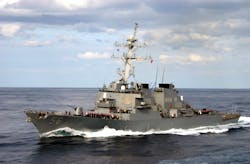U.S. Navy considers machine autonomy to help crewed warships avoid different kinds of collisions at sea
WASHINGTON – U.S. Navy leaders are considering installing machine autonomy aboard surface warships crewed by sailors to help avoid collisions on the high seas. American Military News reports. Continue reading original article
The Military & Aerospace Electronics take:
31 Jan. 2022 -- The service has been testing uncrewed autonomous ships and submarines, yet the technology largely has been limited to exercises and sea trials, as policymakers grapple with how these vessels would be used in combat.
Installing autonomous and machine learning technology on crewed ships could be one way to prove the technology's worth, says Tom Reynolds, senior director of business development for shipbuilder Huntington Ingalls Industries Technical Solutions in Newport News, Va.
This type of technology might possibly have aided the crews of the USS John S. McCain and the USS Fitzgerald, Arleigh Burke-class destroyers that sustained collisions with merchant ships in separate 2017 incidents. Lack of crew rest was cited as a contributing factor.
Related: Artificial intelligence and machine learning for unmanned vehicles
Related: Artificial intelligence (AI) in unmanned vehicles
Related: Triton maritime surveillance UAV technology upgrades: Navy's just getting started
John Keller, chief editor
Military & Aerospace Electronics
